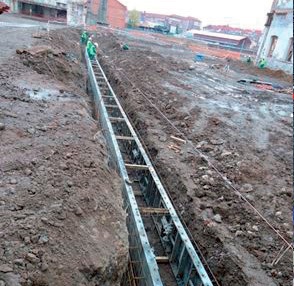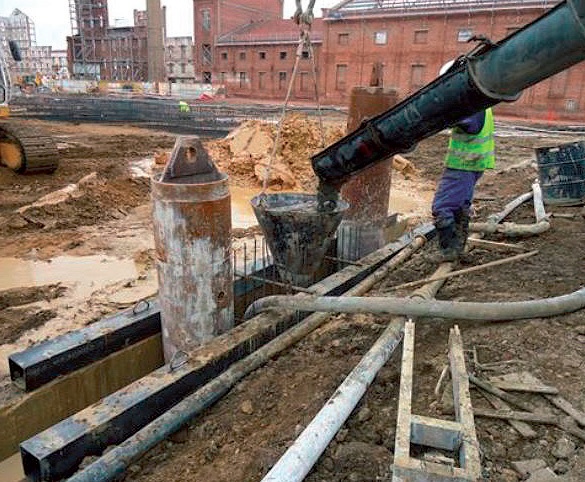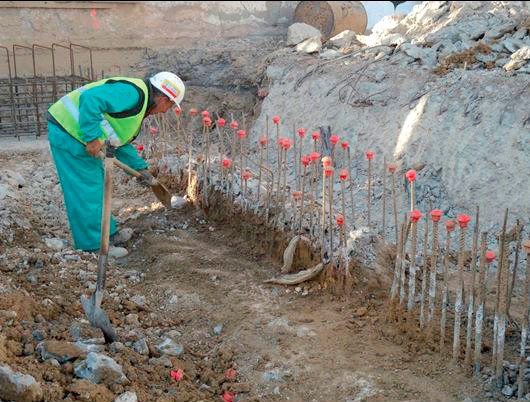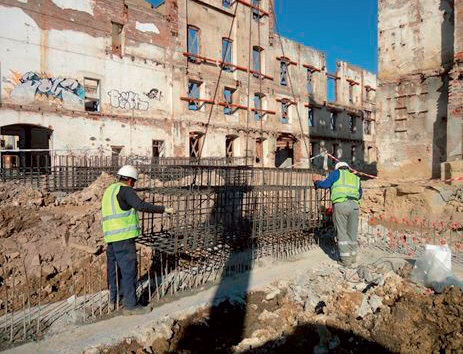Leon Conference and Exhibition Centre
Description of the Environmental Measure
Problem detected:
Traditionally, in order to make a screen wall, cement is poured above the level of the wall to ensure that the healthy cement (not contaminated with bentonite) reaches the level of the finishing. Subsequently, the screen wall is topped off, that is to say, the contaminated cement is chipped off and removed, and then the crown beam is made.
This system produces waste concrete from the demolition, involves the consumption of gasoil and electricity for the demolition machinery and also produces dust and noise when the concrete is being broken up by picks.
Solutions adopted:
In the Leon Conference and Exhibition Hall project, a decision was made to replace the pile head stripping system and the crown beam with the following process, which has clear environmental advantages compared to the traditional method.
1. First of all, the guide wall is constructed. Its upper edge must match the lower edge of the crown beam.
2. Before concreting the slurry wall, two 20 cm - tall tubes are placed so that the contaminated concrete of the slurry wall is 20 cm higher than the upper edge of the slurry wall. These metal tubes were re-used each time concreting of the slurry walls was done.
3. Once the tubes are fixed in position, the concreting goes ahead up the upper edge of the retaining walls, to ensure that the uncontaminated concrete reaches the upper edge of the wall.
4. Once the concrete is cool, the tubes are removed to proceed with the head stripping of the slurry wall before the concrete sets. As the contaminated concrete is still unset, the head stripping is faster and sustainable, as there is no need to use hammers and therefore no noise is produced and electricity is saved. Also, waste cement has less volume than waste from conventional demolition.
5. During the construction of the adjacent retaining walls, mud containing bentonite will spill over and impregnate the cavities in the metal cages that reinforce the slurry walls constructed previously, so subsequent cleaning will be required. As this is clay, it can easily be removed with a shovel, thereby obviating the need for mechanical means and the associated debris. To ensure that no trace of mud is left in the concrete, a final cleaning is carried out using a high-pressure water hose.
6. Finally, the crown beam is laid. As the upper edge of the slurry wall matches the lower level of the crown beam, this serves as a supporting surface and level for the crown beam to fit, which reduces the consumption of concrete that would otherwise be needed to produce this supporting surface.
7. At the same time as earth is removed to place the anchors, the slurry wall situated on the side where the earth is to be excavated is removed. As the other guide wall will be left in the soil below the crown beam, there is no need to demolish it, which eliminates the production of debris unlike the traditional technique, as well as eliminating noise and dust.
Results:
This innovative building technique not only means that the work can be done more quickly, leading to an improved output, but also contributes to better environmental protection, as it reduces both noise pollution and atmospheric emissions. In addition, the solution adopted reduces power consumption and the amount of debris left behind, in contrast to the conventional method.












